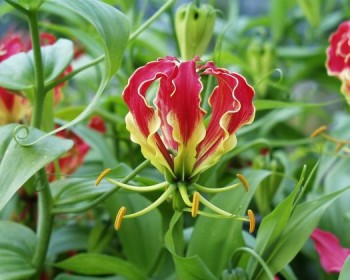
|
|
Gloriosa rothschildiana
|
Gloriosa
This
group consists of 5
or 6 tender, tuberous-rooted, deciduous, climbing vines, which are natives
of South Africa and India. These members of the Lily family, Liliaceae, (Commonly
known as Climbing Lilies; Flame Lilies; Gloriosa Lilies; Glory Lilies)
are suitable for growing on trellises, in containers indoors and outdoors
and as houseplants. They produce weak, trailing stems clothed with glossy
leaves, which are tipped at the ends with tendrils to aid in climbing.
These plants can reach heights up to 8 feet. Flame Lilies are valued for
their exotic, 4- to 5-inch
flowers whose wavy-edged petals are reflexed back as if blown by a strong
wind. If the flowers are cut just before the petals bend back, they will
last up to 8 days in an arrangement. Split the end of the main stem before
putting it into the vase. G. rothschildiana is the prettiest of the Flame
Lilies, reaching 3 to 6 feet in height and having whorled leaves. The wavy
petals of its flowers are crimson, edged in bright yellow making the
blossoms look like they're on fire. G. simplex produces orange and yellow
flowers that open with a light greenish tinge. The vines reach about 3
feet in length. G. superba var. Lutea has pure yellow flowers with slender
petals.
Gloriosa Rothschildiana is
more commonly known as the Gloriosa Lily or Glory Lily from the latin gloria
meaning honour, fame. This splendid and exotic lily was named after Baron
Z.W. Rothschild, an authority on birds, who brought the flower from Africa
and entered it at an exhibition of the English Horticultural Society at
the turn of the century.
Originally from tropical Africa, Gloriosa is the national flower of
Zimbabwe. Since then it has
mainly been grown in Holland. It was first cultivated in the UK in 1902.
Gloriosa
also grows wild in Sri Lanka's warm, moist environment. It's looking much like the sweet potato
plant. It is deadly poisonous, a single ounce being enough to cause stomach
cramps, vomiting,
diarrhoea and death.
In the past, Sri Lanka's traditional healers used a paste derived from
Gloriosa roots to treat scorpion stings and insect bites. On
rare occasions, the yam of this beautiful climber, was cooked with food to
commit homicide on an unsuspecting victim.
Today Gloriosa
has been shown to have even more valuable medicinal properties. Its seeds
and roots contain the alkaloid Colchicine, which has many uses in the
pharmaceutical industry. The drug has been used to treat gout and
rheumatoid arthritis and Colchicine derivatives are now being employed in
cancer chemotherapy.
Thanks to its medicinal
properties, this wild plant, which until a few
years ago was considered just a poisonous weed, is proving to be a
lucrative cash crop for Sri Lanka farmers.
Source:
http://www.botany.com/gloriosa.html
http://www.flowers.org.uk/flowers/facts/e-j/gloriosa.htm
http://www.qathailand.com/Thammasat/Thammasat_5.htm
http://www.mssrf.org/fris9809/srilanka-ch3-d.html
